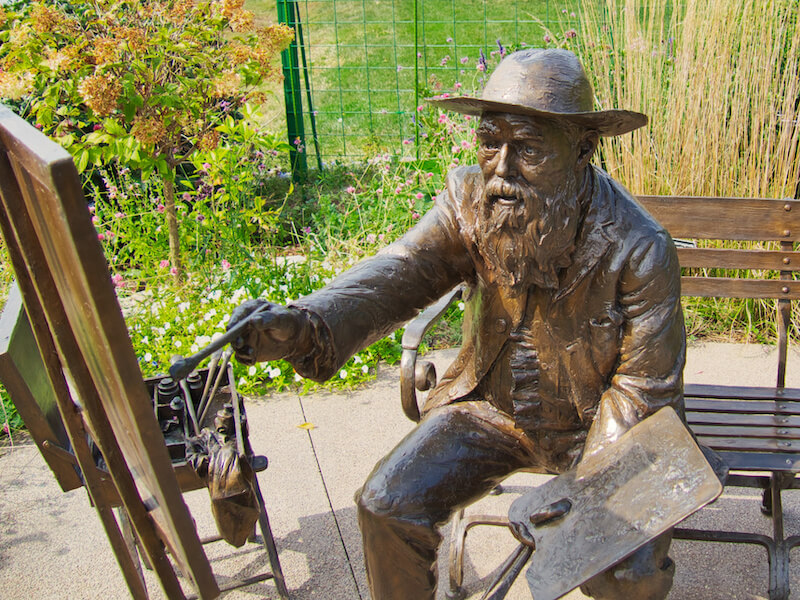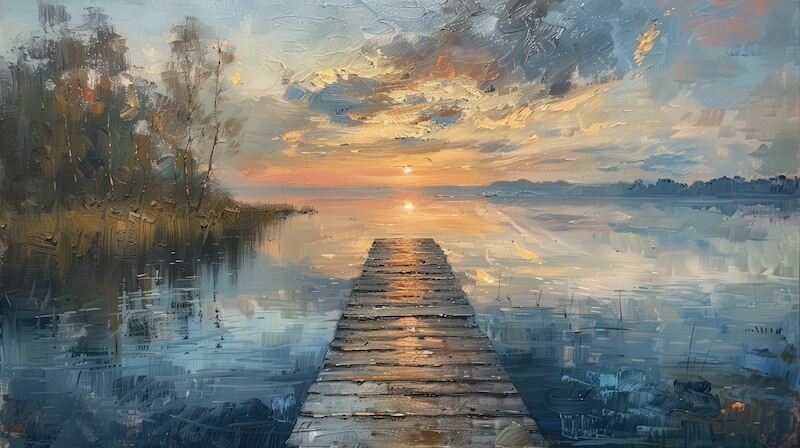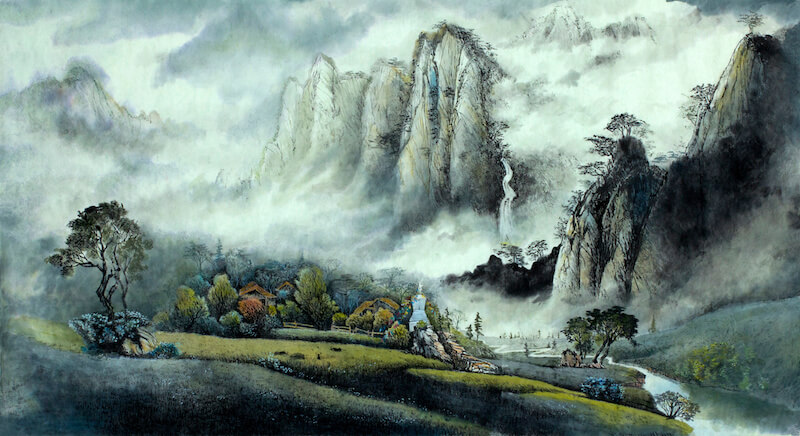Landscape paintings by renowned artists reveal the intricate beauty of nature and the unique emotions tied to it. By exploring key works, you can discover how color, light, and composition shape our understanding of landscapes and inspire wall art in the home, office, and beyond. These masterpieces influence our perception and hold significance for contemporary art. What can we learn from them? Let’s dive into the world of landscape art and uncover how these masterpieces draw inspiration from nature and historical art movements, impacting contemporary art.
Highlights of Famous Landscape Paintings
- Claude Monet’s “Water Lilies” series captures serene beauty through changing light effects and vibrant colors in a water garden setting.
- Vincent van Gogh’s “The Starry Night” reflects emotional turmoil. Its swirling skies and unique brushwork showcase deep colors and textures.
- Thomas Cole’s “The Oxbow” contrasts wilderness and cultivated land, using light and shadow to symbolize preservation versus development in nature and highlighting the landscape’s expressive qualities.
- Winslow Homer’s “Gloucester Harbor” portrays a coastal atmosphere, highlighting dynamic light and color to express appreciation for nature’s beauty.
- Albert Bierstadt’s “Looking Down Yosemite Valley” idealizes the Sierra Nevada mountains, emphasizing romanticized landscapes through intricate light and shadow play.
Introduction to Landscape Art
Landscape painting is an art form that captures the beauty of nature, showcasing elements like trees, water, and mountains. This type of painting is as versatile as it is awe-inspiring. A landscape can be the centerpiece of an art museum’s display or a standout feature of natural wall decor—and everything in between.
Its history spans various movements, reflecting shifts in style and technique, from the realism of early artists to the vibrant expressions of Impressionism. Many artists who contributed to the evolution of landscape painting had formal training in fine arts, which influenced their techniques and perspectives.
Definition of Landscape Painting
While many art forms focus on different subjects, landscape painting emphasizes the beauty of nature and its elements. These artworks capture natural beauty through scenes featuring trees, mountains, water, and skies, as interpreted by the landscape artist. Landscape paintings can convey real and imagined environments, reflecting the artist’s perspective on nature.
Brief History of Landscape Art
Art has long reflected humanity’s relationship with the natural world, and the evolution of landscape painting showcases this connection. Throughout history, landscape art has transformed through various cultures, influenced by Chinese and Western traditions.
The Impressionist movement marked a turning point. It emphasized plein-air painting, which captures vibrant colors and the effects of light, drawing inspiration from the natural world. Artists like Claude Monet and Vincent Van Gogh explored emotional ties to nature and used innovative techniques to express their experiences.
This genre invites reflection on themes of solitude and mortality, deepening one’s understanding of the intricate bond between humans and the landscapes around them.
Famous Landscape Paintings

When you explore famous landscape paintings, you’ll encounter works that define the genre. Each piece showcases unique artistic techniques and invites you to appreciate the interplay of light, color, and emotion. As you examine these artworks, consider how they reflect the beauty and complexity of the natural world.
Water Lilies – Claude Monet
Claude Monet’s “Water Lilies” series is a remarkable exploration of light and color in landscape paintings.
This collection, which includes around 250 works, showcases Monet’s fascination with his tranquil water garden in Giverny, France. By painting plein-air, he captured the changing effects of light on the water’s surface, using vibrant, unblended colors and open brushwork typical of Impressionism.
The paintings often blur the lines between water and sky, inviting viewers to experience the serene beauty of nature. “Water Lilies” symbolizes Monet’s mastery of seizing fleeting moments in the natural world.
The Starry Night – Vincent van Gogh
Vincent van Gogh’s “The Starry Night,” created in 1889, is a stunning example of how landscape painting can convey deep emotional resonance. This masterpiece features swirling skies and vibrant colors that reflect van Gogh’s emotional turmoil.
The fictitious village lies beneath a dramatic night sky, showcasing his unique brushwork that emphasizes movement. Van Gogh’s impasto technique adds texture and depth to the clouds and stars with expert use of blue’s complementary colors, inviting you to feel the scene’s energy.
The towering cypress tree symbolizes a connection between earth and the afterlife, making “The Starry Night” a powerful expression of spirituality and personal experience.
The Oxbow (The Connecticut River Near Northampton) – Thomas Cole
Thomas Cole’s “The Oxbow,” painted in 1836, is a pivotal work by the American landscape painter, illustrating the juxtaposition of untamed wilderness and cultivated land. This famous landscape shows a dramatic contrast between the stormy wilderness on the left and the serene, settled valley on the right.
An influential American artist, Cole uses light and shadow to highlight the lush greenery, inviting you to appreciate nature’s beauty and power. For aficionados interested in hanging a print of this stunning landscape, pairing its natural palette with colors that go with green can tie any room together.
The oxbow bend of the Connecticut River metaphorically represents the choices between preservation and development, embodying the tension of American Romanticism in this iconic artwork.
Gloucester Harbor – Winslow Homer
Winslow Homer’s “Gloucester Harbor” is a remarkable example of American landscape painting, particularly of marine subjects. This oil painting beautifully captures the serene atmosphere of the coastal scene and showcases the dynamic interplay of light and water.
You’ll notice how Homer masterfully uses color and composition to reflect his deep appreciation for nature. Often painting during his vacations, he explored tranquil marine landscapes that invite viewers to connect with the beauty of the environment.
“Gloucester Harbor” is one of many notable works solidifying Homer’s legacy in landscape art.
Sunlight and Shadow – The Newbury Marshes – Martin Johnson Heade
“Sunlight and Shadow – The Newbury Marshes” by Martin Johnson Heade offers a stunning portrayal of the natural beauty found in New England’s marshlands.
In this painting, Heade brilliantly captures the interplay of light and shadow, showcasing vibrant colors that bring the lush greenery and reflective waters to life. You’ll feel a sense of tranquility as you immerse yourself in the serene atmosphere—a feature that makes the painting perfect for bedroom wall decor.
His meticulous attention to detail reveals the expressive qualities of the natural world, especially how light transforms landscapes throughout the day.
Heade’s work invites you to appreciate the beauty and complexity of nature’s ever-changing moods.
Looking Down Yosemite Valley – Albert Bierstadt
Albert Bierstadt’s “Looking Down Yosemite Valley” is a striking example of landscape painting’s ability to evoke awe and reverence for nature.
Completed in 1865, this artwork highlights the breathtaking beauty of the Sierra Nevada mountains and showcases Bierstadt’s affiliation with the Hudson River School. In addition to Yosemite, Bierstadt captured the grandeur of the Grand Canyon, showcasing his ability to depict significant natural sites.
His meticulous plein-air technique captures the romantic idealization of nature, emphasizing light and shadow that enhance the valley’s majestic scale.
This painting significantly influences art history. It invites you to connect with the serene atmosphere of Yosemite Valley and inspires a deeper appreciation for our natural environment.
Road Near Mont Sainte-Victoire – Paul Cezanne
Paul Cézanne’s “Road Near Mont Sainte-Victoire” exemplifies the artist’s innovative approach to landscape painting. Geometric shapes and bold colors create a unique representation of the natural world.
In this artwork, Cézanne breaks from a traditional perspective, focusing instead on the arrangement of elements to convey the scene’s essence. The iconic Mont Sainte-Victoire mountain symbolizes his profound connection to the Provençal landscape.
Using thick layers of paint, or impasto, he enhances the visual texture, contributing to the Post-Impressionist movement and influencing modern art directions, especially Cubism.
This piece invites you to appreciate its layered complexity.
The Flamingos – Henri Rousseau
Henri Rousseau’s “The Flamingos” is a remarkable example of landscape painting that blends reality with imagination. Its colors and tropical feel make it ideal for coastal wall decor.
This enchanting artwork features vibrant colors and bold brushwork that evoke a dreamlike quality. The serene scene features flamingos amidst exotic foliage, showcasing Rousseau’s fascination with nature.
His distinct naïve art style merges real and fantastical elements, inviting you to connect emotionally with the lush jungle landscape. Through this piece, Rousseau reflects his self-taught approach, offering a unique perspective on traditional landscape painting.
“The Flamingos” truly captures the beauty and complexity of the natural world, inviting your admiration.
Black Mesa Landscape, New Mexico – Out Back of Marie’s – Georgia O’Keeffe
Georgia O’Keeffe’s “Black Mesa Landscape, New Mexico—Out Back of Marie’s” is a seminal work that exemplifies the unique approach to landscape painting of this famous Southwestern artist. The captivating piece features a sweeping vista of the New Mexico landscape, with the majestic Black Mesa rising prominently in the distance. Her use of bold, vibrant color schemes and abstract forms creates a sense of depth and dimensionality, drawing the viewer into the heart of the landscape.
O’Keeffe’s fascination with the New Mexico and its unique natural landscapes is well-documented, and “Black Mesa Landscape” is a testament to her deep connection with the American Southwestern art. The painting’s emphasis on color and form, rather than representational accuracy, reflects O’Keeffe’s modernist approach to landscape art. Her innovative use of simplified shapes and striking hues captures the essence of the landscape, inviting you to experience its beauty in a new light.
As a pioneering female artist, O’Keeffe’s contributions to the development of American modernism cannot be overstated. Her innovative approach to landscape painting, as seen in “Black Mesa Landscape,” has inspired generations of artists and continues to be celebrated as a landmark work in the history of American art.
Characteristics of Famous Landscape Paintings

The use of light and color is crucial in landscape painting, shaping the viewer’s experience.
Artists often focus on how natural elements like trees, water, and mountains interact with these elements to evoke specific emotions. Many of these artists had formal training in fine arts, which significantly influenced their techniques and thematic focus.
Use of Light and Color in Landscape Painting
While exploring landscape painting, you’ll quickly notice how crucial light and color are in conveying emotions and setting the mood. Using light and color can transform a simple scene into a breathtaking experience, highlighting the expressive qualities of the landscape.
For instance, vibrant hues in Vincent Van Gogh’s works express deep emotion, while Claude Monet’s manipulation of light reveals the beauty around a river near his garden.
Impressionist artists often emphasize fleeting moments, capturing the shifting atmosphere with rapid brush strokes. Understanding these techniques enhances your appreciation, allowing you to connect more deeply with the art and the intentions behind the colors and light used in landscape paintings.
Depiction of Nature and the Environment
Landscape paintings serve as a window into the natural world, showcasing its beauty and complexity. Artists like Caspar David Friedrich capture the vastness of nature, often highlighting themes of solitude and introspection.
The Cubist movement also redefined landscapes, presenting fragmented views that challenged traditional perceptions. These diverse approaches emphasize our emotional connection with our environment, whether through realistic representations or imaginative scenes.
Influential Landscape Artists
When you think about influential landscape artists, Vincent van Gogh, Claude Monet, and Georgia O’Keeffe stand out for their unique contributions. Each landscape artist brought a distinct style that transformed how we perceive nature in art, from van Gogh’s emotional depth to Monet’s play with light and O’Keeffe’s bold colors.
Understanding their techniques can enhance your appreciation of landscape paintings and inspire your own artistic journey.
- Vincent van Gogh: Known for his expressive use of color and thick impasto technique, Van Gogh captured the emotional depth of nature in en-plein air landscapes like The Starry Night.
- Claude Monet: A pioneer of Impressionism, Monet used light, color, and loose brushwork to create iconic landscape series like Water Lilies, portraying nature’s fleeting beauty.
- Georgia O’Keeffe: Renowned for her bold, abstract interpretations of the New Mexico landscape, O’Keeffe’s work highlights nature’s beauty through vibrant colors and intimate compositions.
- Paul Cézanne: A Post-Impressionist innovator, Cézanne’s structured, geometric landscapes like Mont Sainte-Victoire laid the foundation for modern abstract art.
Evolution of Landscape Art

Landscape art has transformed significantly from its traditional roots to contemporary expressions. You’ll see how techniques and styles have shifted, reflecting both the natural world and artists’ personal interpretations.
From Traditional to Contemporary Landscape Art
As artists sought to express their connection to nature, landscape art evolved significantly over the centuries. Beginning with traditional approaches like Chinese landscape painting and Western realism, artists focused on natural beauty and emotional expression.
The Impressionism movement then emerged, capturing fleeting moments in nature through light and color. The Barbizon School promoted open-air painting, influencing future styles. Innovative techniques introduced by artists like Cézanne and Van Gogh broke traditional rules, paving the way for modern interpretations.
Today, contemporary landscape art continues to explore the intricate relationship between humans and nature, blending abstraction with deep emotional and social themes.
Modern Landscape Artists
Modern landscape artists have redefined the boundaries of traditional art by integrating innovative perspectives and abstract elements into their work. They’ve moved beyond realism, inspired by movements like Post-Impressionism and Fauvism, which emphasize vibrant colors and geometric forms.
You’ll notice how these artists express human emotions and environmental concerns, reflecting the complex relationship between people and nature. With the rise of digital media, landscape art has further evolved, allowing for unique expressions through photography and digital techniques.
Frequently Asked Questions
Who Is the Pioneer of Landscape Painting?
Claude Lorrain is often regarded as the pioneer of landscape painting. His works beautifully blend nature and light, inviting viewers to appreciate the serene beauty of landscapes and inspiring future artists to explore this captivating genre.
Who Is the Famous Landscape Painter on PBS?
You might know Bob Ross, the famous landscape painter on PBS. His soothing voice and “happy little trees” technique encourage people to embrace creativity, making painting feel accessible and inviting for everyone, regardless of skill level.
The Impact of Landscape Paintings
Landscape paintings by famous artists offer a rich exploration of nature’s beauty and complexity. By examining works like Monet’s “Water Lilies” and van Gogh’s “The Starry Night,” you can appreciate how different styles convey emotional depth and the relationship between humanity and nature. Hanging a print of one of these landscapes in your home can even help you choose an interior design color palette. Understanding the characteristics and evolution of landscape art enhances your perspective, allowing for a deeper connection with these masterpieces and their representation of our environment.




